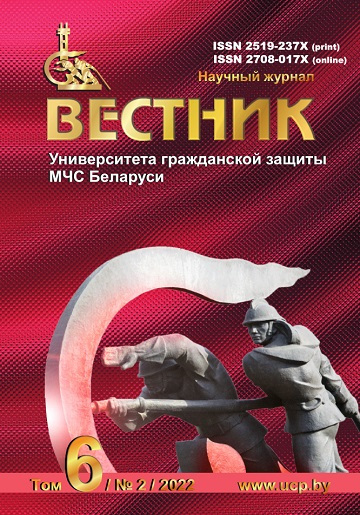Экспериментальные исследования подачи струи компрессионной пены
DOI:
https://doi.org/10.33408/2519-237X.2022.6-2.201Ключевые слова:
установка генерирования компрессионной пены, компрессионная пена, дальность подачиАннотация
Цель. Определение оптимальных технических характеристик и способов применения отечественной установки генерирования компрессионной пены.
Методы. Гидравлические расчеты, экспериментальные исследования.
Результаты. Рассмотрены технические особенности и тактические возможности установок генерирования компрессионной пены (далее – УГКП). Экспериментальным путем определена дальность подачи струи компрессионной пены в зависимости от характеристик пены, диаметра насадка пожарного ствола и избыточного давления на выходе из него. Полученные в исследовании экспериментальные данные были использованы при разработке технических условий на УГКП – 2/8-50.
Область применения исследований. Полученные результаты могут быть применены при разработке методических рекомендаций по применению установок генерирования компрессионной пены для целей пожаротушения.
Библиографические ссылки
Carey W.M. National class A foam research project technical report: Structural fire fighting-room burn tests phase II. National Fire Protection Research Foundation. Quincy, Massachusetts, USA. 1994.
Colletti D.J. Class A foam for structure firefighting. Fire Engineering, 1992. Vol. 145, No. 7. Pp. 47–56.
Liebson J. Introduction to class A foams and compressed air foam systems for the structural fire service. MA: International Society of Fire Service Instructors, 1991. 45 p.
Colletti D.J. Compressed air foam systems and fire hose. Fire Engineering, 1996. Vol. 149, No. 7. Pp. 50–52. EDN: https://www.elibrary.ru/CJFVMZ.
Murdock, J.I. Compressed air foam systems: A project pertaining to an adoption decision. (ExecutiveDevelopment Research Paper). Emmitsburg, MD: National Fire Academy. 1997.
Gavyrin N.P. Issledovanie raboty gidromonitorov [Investigation of the operation of hydraulic monitors]: monograph. Moscow, 1939. 244 p. (rus)
Zdor G.N., Potekha A.V. Utochnenie zavisimostey dlya postroeniya ogibayushchikh krivykh kompaktnoy i razdroblennoy gidravlicheskikh struy lafetnykh stvolov pozharnykh robotov [Refinement of dependencies for constructing envelope curves of compact and fragmented hydraulic jets of carriage trunks of fire robots]. Vesnik of Yanka Kupala State University of Grodno. Series 6. Engineering Sciences, 2015. No. 2 (204). Pp. 68–77. (rus). EDN: https://www.elibrary.ru/YQPGKX.
Balaganskiy I.A. Osnovy ballistiki i aerodinamiki [Fundamentals of ballistics and aerodynamics]: tutorial. Novosibirsk: NGTU, 2017. 200 p. (rus)
Lysenko L.N. Vneshnyaya ballistika [External ballistics]: tutorial. Moscow: Bauman University, 2018. 328 p. (rus)
Zdor G.N., Potekha A.V. Opredelenie traektorii naklonnoy gidravlicheskoy strui s uchetom deystviya sily treniya, voznikayushchey na ee poverkhnosti [Determination of the trajectory of an inclined hydraulic jet taking into account the action of the friction force arising on its surface]. Vesnikof Yanka Kupala State University of Grodno. Series 6. Engineering Sciences, 2015. No. 2 (204). Pp. 88–97. (rus). EDN: https://www.elibrary.ru/YPCHTH.
Kamlyuk A.N., Grachulin A.V. Kompressionnaya pena dlya nuzhd pozharnykh podrazdeleniy [Compression foam for the needs of fire departments]: monograph. Minsk: University of Сivil Protection, 2019. 224 p. (rus)
Опубликован
Как цитировать
Лицензия
Все права защищены (c) 2022 Скорупич И.С., Грачулин А.В., Шинкоренко К.Е.

Это произведение доступно по лицензии Creative Commons «Attribution-NonCommercial» («Атрибуция — Некоммерческое использование») 4.0 Всемирная.




















